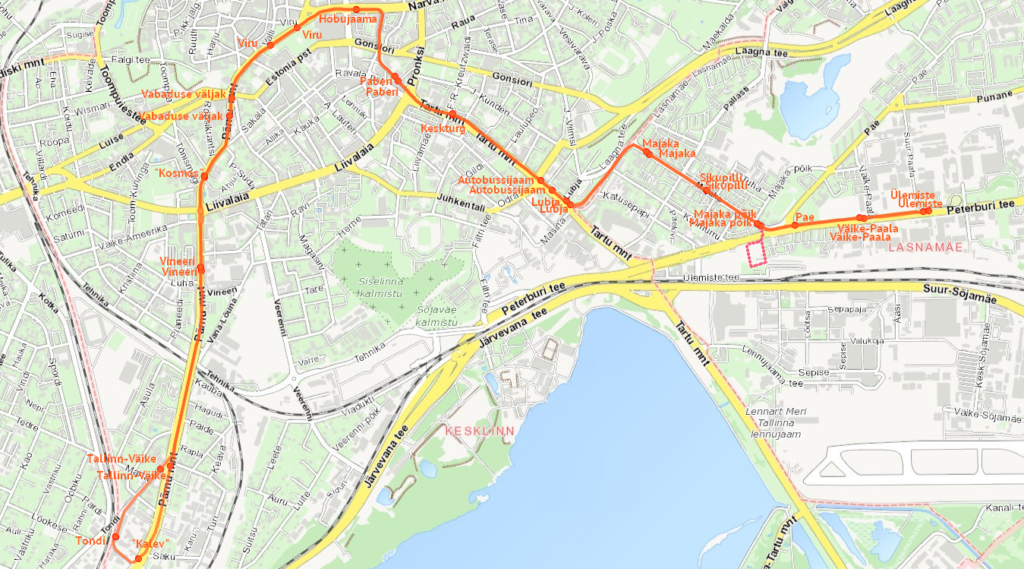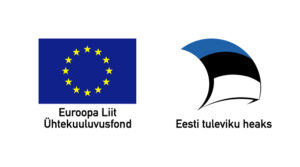Reconstruction of tram route No. 4

As part of the modernisation of the infrastructure of Tallinn’s 3rd and 4th tram routes, a total of six kilometres of track were reconstructed together with the base layer (wooden sleepers were replaced with a concrete base and the old rails were replaced with continuous welded ones). A concrete base was installed on the section between Freedom Square and Vineeri Street (up to the viaduct on Pärnu maantee), the section from Hagudi Street to the Tondi terminal and back, and the section between the stops on Vineeri Street and Freedom Square. In addition, the track on Majaka Street, which already had a concrete base, was renovated, as the old, worn rails were in need of replacing. The need for a concrete base was due to the acquisition of new trams, which had a higher axle load. For the same reason, a three-kilometre stretch of tramway as well as a kilometer’s worth of tracks on the entry and exit path and balloon loop were reconstructed at the tram depot on Pärnu maantee. Points were replaced. For the new trams, a canopy was built over the parking area on the territory of the Vana-Lõuna depot to protect the trams from the elements.
In addition, the project saw the construction of 700 metres’ worth of new tracks at Peterburi tee 2, including a balloon loop and overhead lines, and the necessary traffic control facilities. Cabling work was carried out to connect the new section to the substation, and a new traffic light controlled junction was built.
At substations, degraded equipment was replaced with modern and more environmentally friendly systems. The renovation of the substations was also linked to the introduction of the new trams, as the substations had to conform to the technical requirements of the trams. 6 kV and 600 V equipment, rectifiers, and cables were replaced in all substations. The historic building of traction substation No. 1 was renovated.
The entire overhead line system of tram route No. 4 was replaced – also to accommodate the energy needs of the new trams. Degraded overhead line towers were replaced in accordance with the preliminary plan. In total, 38 kilometers’ worth of overhead lines were replaced.
As the new trams were to be launched not only on route No. 4, but also on route No. 3 (Tondi – Kadriorg), the section Hobujaama – Kadriorg – Hobujaama was also renovated. This section had already been switched over to a concrete base between 2001 and 2008, but operating the new trams required the DC feeder cable from substation No. 4 to be restored.
The aim of the project was to increase the speed of tram transport and the number of tram users on the route, as well as to increase the average speed of public transport. To achieve this, previous traffic schemes on the city’s streets were also changed.
Contractor
To implement the project, Tallinna Linnatranspordi AS launched the public procurement No. 146293 titled ‘Designing and Reconstruction of Infrastructure for Tram Route No. 4’, the contract for which was awarded to a consortium formed by AS Merko Ehitus Eesti, KMG Inseneriehituse AS, and Ratatek OY. The cost of the project was 26,040,071.72 euros.
Period of execution of the work
The work was carried out between February 2014 and September 2015.
Planning
The work was performed on the basis of a preliminary plan prepared in collaboration between SWECO Projekt AS and AS Elektritsentrum, which was supplemented to match the scope of the construction project by the consortium that was awarded the public contract.

Funding
In accordance with the decision of the management board of the Centre for Environmental Investments (Keskkonnainvesteeringute Keskus – KIK) of 28 March 2013, the project was funded in the amount of 18.91 million euros from the EU Cohesion Fund measure to support the development of sustainable transport. The own contribution and the costs exceeding the initial budget of the project were borne by the City of Tallinn.
The preparation of the preliminary plan was financed from the proceeds of an assigned amount unit purchase agreement (AAUPA) between the Republic of Estonia and the Kingdom of Spain.
Project stages
Stage 1: Construction of a balloon loop on Peterburi tee (April 2015 – September 2015)
During the first stage of the project, the construction of the extension of the tramway at the intersection of Peterburi tee and Majaka Street, which was started in 2014, was continued. A balloon loop was constructed at Peterburi tee 2. The work included the construction of tram stops, tracks with overhead lines, and street lighting. Points were installed in the area of Majaka põik to connect the balloon loop to the existing tramway. A railway terminal was planned to be constructed for Rail Baltica right next to the balloon loop; in 2017, the tramway was connected to Tallinn Airport via the balloon loop.
Stage 2: Reconstruction of the tramway from the Viru Roundabout to Tondi Street (April 2014 – September 2015)
The majority of the work was carried out in 2014 in parallel with the work performed on the tramway to Kadriorg. The introduction of the new trams required the infrastructure to be upgraded to support trams with a maximum authorised weight of up to 70 tonnes. In addition to the renewal of the tracks, it was necessary to replace the overhead lines and renovate the substations.
Stage 3: Reconstruction of the tramway from Hobujaama to Majaka põik (June 2014 – September 2015)
During the third stage, sections that had not been reconstructed during the reconstruction of Tartu maantee were fitted with a concrete base. This essentially concerned the section of tramway running from Lubja Street (so-called ‘Lubja Rise’ or Lasnamäe Street) to the intersection of Majaka Street and Peterburi tee. The section of the tramway along Peterburi tee, which will continue to carry only lighter trams, was not reconstructed.
Stage 4: Replacement of overhead lines between Hobujaama and Kadriorg (July 2014 – November 2014)
The tramway to Kadriorg was switched over to a concrete base in its entirety in 2008. In order to support the new trams, it was only necessary to replace the overhead lines on the section between Hobujaama and Kadriorg.

